
Barack Obama may be the leader of the world’s most powerful democracy, but not its largest one; that distinction belongs to Indian Prime Minister Narendra Modi, whom Obama wrote about in our recent TIME 100 issue. Modi is now completing his first year in office, and the sense of expectation and energy in his country is palpable. When I met with him earlier this month at his residence in New Delhi, with TIME Asia editor Zoher Abdoolcarim and South Asia bureau chief Nikhil Kumar, Modi was at the center of a whirlwind, with an ambitious reform program at home, 16 trips abroad with China up next, a new al-Qaeda threat against him, and economists challenging whether he would be able to drive India to the 8% GDP growth projected for the coming fiscal year.
We discussed these topics and more over the course of two hours, in the only extended interview he has given as Prime Minister. A recurring phrase, like the chorus to each verse of the conversation, was “I firmly believe,” and indeed he projects a sense that he plans to move his country into the forefront of nations by force of will and conviction. He was by turns practiced and passionate as he talked about what it will take to overcome India’s modern history of missed opportunities, what it will take to drive economic growth without environmental damage and what distinguishes the U.S.-India relationship after years of often awkward interaction. For the U.S. and India are more than just the world’s two biggest democracies. They are diverse, multiethnic and multicultural democracies, and at a moment when many nations are debating how to balance national identity with ethnic diversity, India continues to provide a bracing example.
Modi’s ideological roots lie in a strain of Hindu nationalism that can make minority Muslims and Christians uneasy. But he went to great lengths to address that concern. “The diversity of India, of our civilization, is actually a thing of beauty,” he said, and noted as well that “India by its very nature is a democracy. It is not just as per our constitution that we are a democratic country; it is in our DNA.” A devout belief in the power of those values is essential to move India forward, he argued, and whether Modi can succeed will provide no end of lessons to young democracies that are watching him closely.
Nancy Gibbs, EDITOR
What You Said About …
Our widely shared May 11 cover image of a scene from the heart of Baltimore’s unrest was taken by amateur photographer and Baltimore resident Devin Allen, whose Instagram feed brought him to the attention of TIME editors. Since we published it on April 30, the cover has generated a groundswell of reaction, trending nationally on Twitter and on Reddit’s front page; sparking debate on radio and TV programs like ABC’s This Week, NPR’s Here and Now and PBS’s NewsHour; and inspiring Beyoncé, for one, to share it with her 31 million Instagram followers. A sampling of the reaction:
“One of the most powerful cover shots I’ve ever seen.”
–@AJ_BARBOSA
“Disturbingly accurate.”
–@DUNKNOWN1
“Like adding gasoline to the fire.”
–CARLOS RANGEL, FETCHER, N.C.
“It captures an image of the Baltimore protests that is not only succinct but also accurate … Allen’s photos have captured the heart of the protests and riots.”
–AFRICAN-AMERICAN NEWS SITE THE ROOT
“You’ve sensationalized a couple of tragedies while ignoring more horrifying scenarios.”
–DARELL TAPP, GILBERT, ARIZ.
“The temptation is to believe that nothing has changed, but something has: Baltimore is blacker and poorer.”
–JELANI COBB, IN THE NEW YORKER
“Brilliant but terrifying.”
–@USMANAHMAD_IAM
“A lot of people say Baltimore has never recovered from those riots in 1968. What’s it going to take to recover this time?”
–GEORGE STEPHANOPOLOUS, ON THIS WEEK
“Never has the phrase ‘The more things change, the more they stay the same’ been more relevant.”
–FISHBOWLNY
More Must-Reads From TIME
- The 100 Most Influential People of 2024
- Coco Gauff Is Playing for Herself Now
- Scenes From Pro-Palestinian Encampments Across U.S. Universities
- 6 Compliments That Land Every Time
- If You're Dating Right Now , You're Brave: Column
- The AI That Could Heal a Divided Internet
- Fallout Is a Brilliant Model for the Future of Video Game Adaptations
- Want Weekly Recs on What to Watch, Read, and More? Sign Up for Worth Your Time
Contact us at letters@time.com